#solenodon paradoxus
Photo
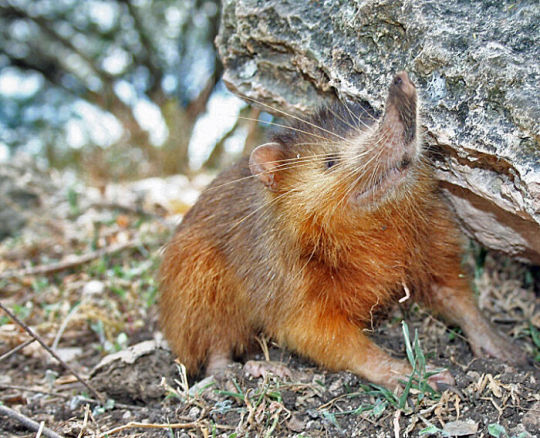
Rarest Animals In The World That Are On The Brink Of Extinction
Hispaniolan Solenodon (Solenodon Paradoxus)
Wikimedia Commons
#wikimedia commons#photographer#hispaniolan solenodon#solenodon paradoxus#animal#mammal#wildlife#nature#extinction#least concern
84 notes
·
View notes
Text

Hispaniolan Solenodon (Solenodon paradoxus), family Solenodontidae, order Eulipotyphla, found on the Caribbean island of Hispaniola (Haiti and Dominican Republic)
This nocturnal insectivorous mammal is venomous.
They are in the same order as moles, hedgehogs, and shrews.
photograph by Pedro Genaro Rodriguez
367 notes
·
View notes
Photo

Hispaniolan solenodon (Solenodon paradoxus)
Photo by Miguel A. Landestoy T.
#cuban solenodon#solenodon paradoxus#solenodon#solenodontidae#eulipotyphla#laurasiatheria#boreoeutheria#eutheria#mammalia#tetrapoda#vertebrata#chordata
229 notes
·
View notes
Text
Animal of the Day!
Hispaniolan Solenodon (Solenodon paradoxus)

(Photo by Miguel Landestoy)
Conservation Status- Endangered
Habitat- Hispaniola Island
Size (Weight/Length)- 907 g; 30.4 cm
Diet- Insects; Mice; Reptiles; Fruit; Worms
Cool Facts- Native to only one island, the Hispaniolan solenodon is an extremely unique animal. Fur covers the majority of their body, with their feet and tail being naked. Being one of the few venomous mammals, the Hispaniolan solenodon is an excellent hunter. Their long snout is used to dig through leaflitter to search for prey. They are nocturnal and spend their days sleeping in burrows or hollow logs. This species of solenodon are relatively slow and clumsy, most likely because the island of Hispaniola lacked predators until invasive populations of dogs and cats were introduced to the island, resulting in a decline of population for the solenodon. Today, massive conservation efforts have been put in place to save this tiny animal.
Rating- 13/10 (Small. Deadly. Oddly cute.)
#Animal of the day#Animals#Mammals#Tuesday#November 30#Hispaniolan solenodon#biology#science#conservation#the more you know
170 notes
·
View notes
Photo

Endangered Inktober - Hispaniolan Solenodon by Ciameth
Day 18 - Hispaniolan Solenodon, Solenodon paradoxus
IUCN Status: Endangered
Solenodons are a unique group of venomous, nocturnal, insectivorous mammals. They diverged from other modern mammal lineages around 73 million years ago, existed alongside dinosaurs, and survived the K-T extinction event at the end of the Cretaceous. Today, two species of Solenodon remain - the Hispaniolan Solenodon, found only on Hispaniola, and the Cuban Solenodon, found only on Cuba. Both are endangered.
The Hispaniolan Solenodon has a long, flexible snout and an incredible sense of smell. They have terrible eyesight and hunt through scent and feel. Unique among mammals, the Solenodons have venomous salivary glands. The venom is injected through grooves on the incisors and used to incapacitate prey.
Unfortunately, the Solenodons are not able to defend themselves against introduced mammalian predators like feral dogs, outdoor cats, rats, and mongooses. They are also trapped for human consumption due to food shortages. The Hispaniolan Solenodon needs more protected habitat, so it has space to thrive away from human habitation, and invasive species on the island need to be eradicated or controlled.
7 notes
·
View notes
Link
Solenodons (meaning "slotted-tooth") are venomous, nocturnal, burrowing, insectivorous mammals belonging to the family Solenodontidae. The two living solenodon species are the Cuban solenodon (Solenodon cubanus), and the Hispaniolan solenodon (Solenodon paradoxus). Both species are classified as "Endangered" due to habitat destruction and predation by non-native cats, dogs and mongooses, introduced by humans to the solenodons' home islands to control snakes and rodents.
3 notes
·
View notes
Text
Ahhhh! Thank you😁❤️❤️❤️❤️
SOLENODON
After many years of research on a genetically and geographically isolated and highly endangered mammal, an international team of scientists managed to sequence the Solenodon genome, and the results are surprising. “The solenodon lineage diverged from other placental mammals circa 78 million years ago. That means [it] has existed since the Cretaceous period,” said Adam Brandt, lead author of a recent study that took the first look at the solenodon’s mitochondrial DNA.
Solenodons are large, plump shrews with elongated snouts and multicolored fur. They grow to about a foot long, and their naked, scaly tails can add another 10 inches. They are some of the most unique and rare mammals in the world, today they are only found on the islands of Cuba and Hispaniola.
The Hispaniolan solenodon is one of the most unusual mammals on the planet.
The two living solenodon species are the Cuban solenodon (Solenodon cubansus) and the larger Hispaniolan solenodon (Solenodon paradoxus). As other physical traits are concerned, solenodons are larger than the shrews they resemble, measuring between 11 and 13 inches (28–33 cm), with the tail adding an additional 10 inches (25 cm), and a weight going up to 2.2 pounds (1 kg).
The Hispaniolan solendon has a ball-and-socket joint at the base of its snout, similar to a human shoulder joint. This increases its mobility and allows it to use its snout to explore narrow crevices for potential prey.
Solenodons find food by rooting in the ground with their snouts and tearing into rotten logs and trees with their powerful foreclaws. Their diet consists mostly of insects, worms, and other invertebrates, but they also feed on fruits, roots, vegetables, and small vertebrates. In captivity, solendons have been known to drink only while bathing.
They’re venomous and are one of only a few venomous mammals. Other venomous mammals, like the duck-billed platypus, are only capable of passively conveying venom; the solenodon actually injects its venom like a snake through specially modified teeth. The second lower incisors have special grooves through which venom flows. In fact, the name “solenodon” is derived from the Greek for “grooved tooth.”
Solenodons have glands in their armpits and groins that secrete what is said to be a musky, goat-like odor. They sleep the day away in burrows. They’re nocturnal, hiding during the day in burrows, caves, or hollowed out logs. They grunt like pigs when they feel threatened, and also make bird-like cries.
Solenodons depend on senses other than sight, because they have tiny eyes and poor vision, but they possess highly developed senses of hearing, touch, and smell. Solenodon nipples are located near their rumps. The female solenodon gives birth to one to three young at a time, but only two will survive. She only has two nipples, and they’re located toward her back, almost on her buttocks. Young solenodons stay with their mothers for several months, which is long compared with other insectivores.
Solenodons have a funny way of getting around, they have a clumsy gait and are incapable of jumping, although they can run and climb surprisingly fast. When they run, they do so on their toes, going in a zig-zagged course. When alarmed, they might trip over their own toes and even tumble head-over-heels.
They’re easy prey for introduced predators. Because of their ungainly gait, solenodons have made easy picking for introduced predators such as cats, dogs, and mongooses. They have also been observed to stop, sit still, and hide their heads when predators pursue them.
11 notes
·
View notes
Text
Hispaniolan Solenodon

Solenodon paradoxus

Countries:
Dominican Republic, Haiti
Interesting facts:
🔔 They are nocturnal and find shelter during the day by burrowing or hiding in hollow logs or crevices.
🔔 It has venomous saliva, which is injected into its prey through specialised grooves in their incisors.
🔔 Solenodons have unusually flexible snouts.
0 notes
Text

Dr Ros Kennerley, Programme Officer for the SMSG
I am the Programme Officer for the IUCN SSC Small Mammal Specialist Group based at Durrell Wildlife Conservation Trust’s Conservation Science Hub in Bath, UK. The position involves the coordination of Red List assessments and the support of development of the SMSG membership and its communication capabilities.
I am passionate about conserving highly threatened species, with all of the challenges but also the enormous rewards that go with this type of work. The majority of my previous experience has been carrying out research and contributing to major conservation programmes for rare mammal and bird species both in the UK and overseas. My PhD research at the University of Reading examined the ecology of Hispaniolan Solenodon (Solenodon paradoxus) and Hutia (Plagiodontia aedium) in native forest and agricultural systems in the Dominican Republic, and to do this I employed a variety of monitoring techniques including GPS, radio telemetry and camera traps. From this experience I became the Caribbean Coordinator for the SMSG and in this role I am keen to expand the research, training and the network of small mammal conservationists operating in the region.
12 notes
·
View notes
Photo

Venomous Mammal Lived with Dinosaurs, Survived Asteroid Impact
Researchers have sequenced the venomous Solenodon, the last survivor of a branch of mammals that appeared at the time of the dinosaurs
Published today, in the open-access journal GigaScience, is an article that presents a draft genome of a small shrew-like animal, the venomous Hispaniolan solenodon (Solenodon paradoxus). This species is unusual not only because it is one of the very few venomous mammals, it is also the sole remaining branch of mammals that split from other insectivores at the time of the dinosaurs.
The genome sequencing and analysis of this endangered animal was carried out by an international team lead by Dr. Taras K. Oleksyk from the University of Puerto Rico at Mayagüez. The availability of the solenodon genome sequence allowed the researchers to answer several evolutionary questions, particularly whether the solenodon species indeed survived the meteor impact that laid waste to the dinosaurs.
Taras Oleksyk talk at the GigaScience prize track on Innovative assembly strategy contributes to the understanding of evolution and conservation genetics of the critically endangered Solenodon paradoxus from the island of Hispaniola. Presented at the International Conference on Genomics on 27th October 2017
More: [X]
1 note
·
View note
Photo


Croquis couleur de Solénodon paradoxal, Solenodon paradoxus //
Dans le cadre de l’inktober de 2017 : #poison.
Le solénodon paradoxal est l’un des rares mammifère à être venimeux. Il vit sur l’île d’Hispaniola et est menacé d’extinction à cause de la perte de son habitat et parce qu’il est la proie d’espèces nouvellement introduites.
Color sketch of a hispaniolan solenodon, Solenodon paradoxus //
For Inktober 2017, #poison.
Here is Solenodon paradoxus, one of the few mammal that have venom. He lives on island of Hispaniola (caribbean) and is endangered because of habitat loss and predation by introduced species.
2 notes
·
View notes
Photo


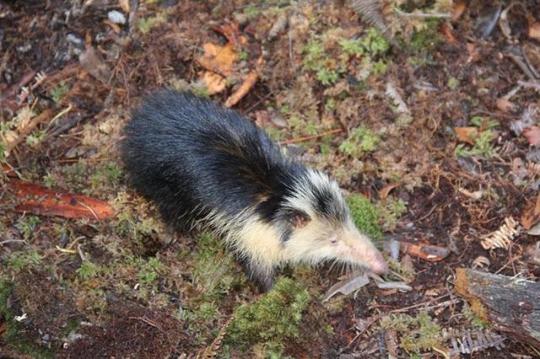
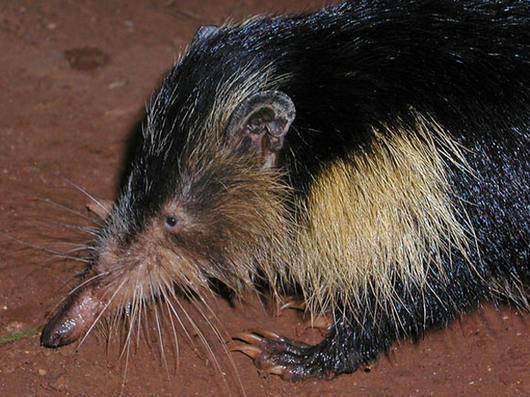





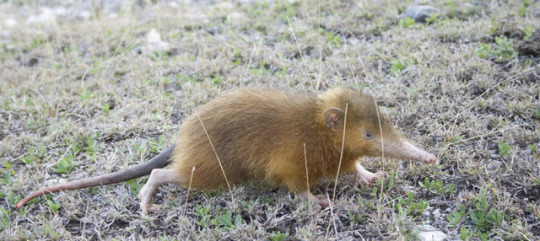
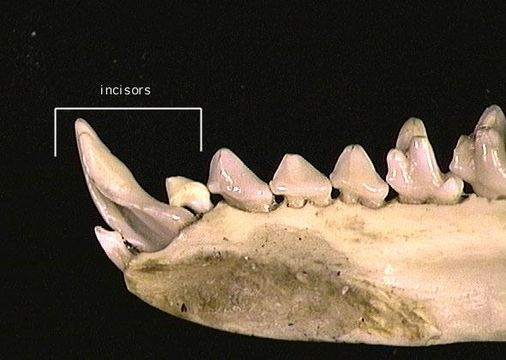
Solenodon
Solenodons (meaning "slotted-tooth") are venomous, nocturnal, burrowing, insectivorous mammals belonging to the family Solenodontidae. Solenodontidae is interesting to phylogenetics researchers because of its retention of primitive mammal characteristics; their species resemble very closely those that lived near the end of the age of the dinosaurs. In 2016, solenodons were confirmed by genetic analysis as predating the mass extinction of the dinosaurs. The two living solenodon species are the Cuban solenodon (Solenodon cubanus), and the Hispaniolan solenodon (Solenodon paradoxus).
Solenodons resemble very large shrews, and are often compared to them; with extremely elongated cartilaginous snouts, long, naked, scaly tails, hairless feet, and small eyes. The Cuban solenodon is generally smaller than its Hispaniolan counterpart. It is also a rusty brown with black on its throat and back. The Hispaniolan solenodon is a darker brown with yellowish tint to the face. The snout is flexible and, in the Hispaniolan solenodon, actually has a ball-and-socket joint at the base to increase its mobility.
Solenodons have a few unusual traits, one of them being the position of the two teats on the female, almost on the buttocks of the animal, and another being the venomous saliva that flows from modified salivary glands in the mandible through grooves on the second lower incisors. Scientific studies on the nature of the tiny mammal's saliva show that it is very similar to the neurotoxic venom of certain snakes. Solenodons create venom in enlarged submaxillary glands, and only inject venom through their bottom set of teeth. The symptoms of a solenodon bite include general depression, breathing difficulty, paralysis, and convulsions; large enough doses have resulted in death in lab studies on mice.
Their diets consist largely of insects, earthworms, and other invertebrates, but they also eat vertebrate carrion, and perhaps even some living vertebrate prey, such as small reptiles or amphibians. They have also been known to feed on fruits, roots, and vegetables. Based on observation of the solenodon in captivity, they have only been known to drink while bathing.
Both extant species are endangered due to predation by the small Asian mongoose as well as by feral cats and dogs. Prior to the arrival of Europeans, the solenodon was the apex predator on the island of Hispaniola. Consequently, the solenodon never evolved defense mechanisms, which is why it is so threatened by predators like dogs, cats, and mongooses. Snakes and birds of prey are also threats. Human activity has also had an adverse effect on the Solenodon population. The Cuban solenodon was thought to have been extinct until a live specimen was found in 2003. The Hispaniolan solenodon was also once thought to be extinct, probably more because of its secretive and elusive behavior than to low population numbers. Recent studies have proven that the species is widely distributed through the island of Hispaniola, but it does not tolerate habitat degradation.
305 notes
·
View notes
Text
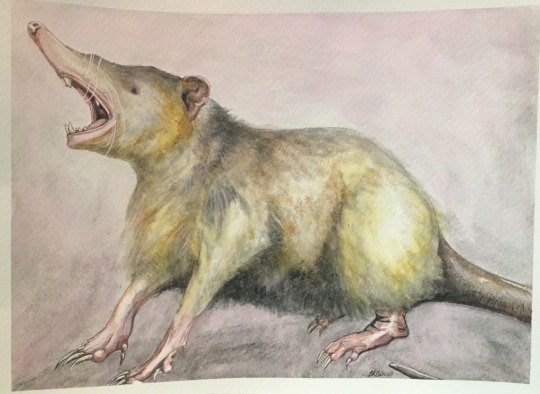
I did a watercolor painting of a solenodon (Solenodon paradoxus)
0 notes
Text
Organism of the Week - Hispaniolan Solenodon

The Hispaniolan solenodon, or Solenodon paradoxus, is in the Animalia kingdom, Chordata phylum, Mammalia class, Eulipotyphla order, and Solenodontidae family.
The Hispaniolan solenodon is described as rare and unique mammals, known for their ability to produce toxic saliva. They have a body length up approximately 11 to 15 inches (280 to 390 millimeters), long tails at a length of 7 to 10 inches (175 to 255 millimeters), and a weight of about 2 pounds (1 kilogram). Their body is covered with black or reddish-brown fur, while their nose, ears, and tails are hairless. They have very small eyes with very underdeveloped vision, though they have highly developed sensesof smell, touch, and hearing. They have flexible snouts that are used to explore through cracks and massive claws to dig for their prey. Their prey consists of invertebrates, such as beetles, crickets, earthwarms, or termites, and amphibians, reptiles, or small birds. To capture their prey, they jump at the victum and pin it down with thier strong forelimbs. Then, they pick up the prey with its lower jaw and bite it, injecting toxic saliva from their lower incisors which makes the prey immobile.
Hispaniolan solenodons are found in the Dominican Republic and Haiti, on the island of Hispanola in a variety of different forests. They are found burrowing or hiding in hollow logs, caves, or burrows during the day because they are nocturnal.


The Hispaniolan solenodon breeds twice a year. The females have an irregular estrus period, although males don’t and can mate at any time. Before mating, the female makes a burrow for her to give birth and nurse her babies. The gestation period is about 50 days until the female fives birth to one to three young in her burrow. The newborns weigh 40 to 55 grams and are 15.2 to 16.3 centimeters in length. They also are born with their eyes close and minimal hair. If three young are born, only two will survive because the female only has two teats near her rump. The baby solenodons are nursed for about 13 weeks, when they start eating solid food. The Hispaniolan solenodon can live up to 11 years.
Fun Fact: Hispaniolan solenodons run on their toes and go in a zig-zagged course, so when they are alarmed they sometimes trip over their own toes.
http://www.arkive.org/hispaniolan-solenodon/solenodon-paradoxus/
http://www.edgeofexistence.org/mammals/species_info.php?id=5
http://animaldiversity.org/accounts/Solenodon_paradoxus/
2 notes
·
View notes
Photo
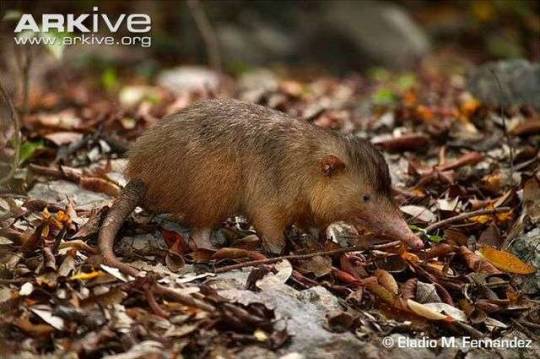
Arkive Species of the Day for December 19, 2017
Hispaniolan solenodon (Solenodon paradoxus)
ENDANGERED
This ancient and distinctive mammal, capable of secreting toxic saliva, faces very real and immediate threats to its survival. One of only two solenodons in existence, the Hispaniolan solenodon (Solenodon paradoxus) resembles a large, stocky shrew, and has a distinctive, elongated snout that extends well beyond the jaw. A unique ball-and-socket joint attaches the snout to the skull allowing remarkable flexibility and mobility. The Hispaniolan solenodon has coarse, grizzled grey-brown fur which varies in pattern from one individual to another. The stiff, muscular tail is grey except for the base and tip which are whitish. It has long, stout sharp claws, particularly well-developed forelimbs, and it walks with a stiff, waddling gait
This rare mammal occurs only in the Dominican Republic and Haiti, on the island of Hispaniola
The Hispaniolan solenodon inhabits a variety of different forests
The Hispaniolan solenodon is one of only a few mammal species capable of producing toxic saliva, which it uses to immobilise its invertebrate prey.
http://www.arkive.org/hispaniolan-solenodon/solenodon-paradoxus/
0 notes
Text
#ConóceAcercaDe : • Fauna característica del Parque Nacional Los Haitises •
La fauna de Los Haitises es de una gran variedad y la de mayor representatividad nacional de todas nuestras áreas naturales protegidas, debido a la diversidad de sus ambientes.
La riqueza en fauna del Parque Nacional Los Haitises queda reflejada entre los mamíferos por la presencia del manatí (Trichechus manatus) en los cayos de manglar, el solenodonte (Solenodon paradoxus) pequeño mamífero insectívoro endémico de la isla, en el bosque, y los murciélagos en las cuevas. Entre los reptiles cabe destacar la presencia de la boa (Epicrates striatus) y las tortugas marinas (Chelonia mydas, Carrretta caretta, Dermocheylys coriacea). Dentro de la fauna, las aves son el grupo más numeroso, 110 especies de las 270 totales del país, pudiéndose distinguir entre las propias del manglar, garzas y otras zancudas.
0 notes